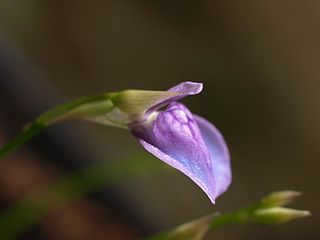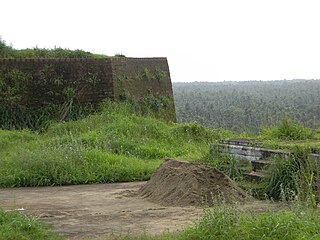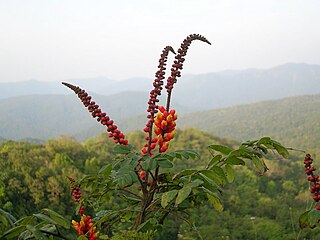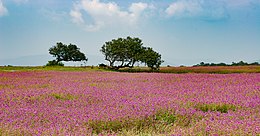
The Western Ghats, also known as Sahyadri, are a mountain range that covers an area of 140,000 square kilometres (54,000 sq mi) in a stretch of 1,600 kilometres (990 mi) parallel to the western coast of the Indian peninsula, traversing the states of Kerala, Tamil Nadu, Karnataka, Goa, Maharashtra and Gujarat. It is a UNESCO World Heritage Site and is one of the eight "hottest hot-spots" of biological diversity in the world. It is sometimes called the Great Escarpment of India. It contains a large proportion of the country's flora and fauna, many of which are only found in India and nowhere else in the world. According to UNESCO, the Western Ghats are older than the Himalayas. They influence Indian monsoon weather patterns by intercepting the rain-laden monsoon winds that sweep in from the south-west during late summer. The range runs north to south along the western edge of the Deccan Plateau, and separates the plateau from a narrow coastal plain, called Konkan, along the Arabian Sea. A total of thirty-nine areas in the Western Ghats, including national parks, wildlife sanctuaries and reserve forests, were designated as world heritage sites in 2012 – twenty in Kerala, ten in Karnataka, five in Tamil Nadu and four in Maharashtra.

Satara is a city located in the Satara District of Maharashtra state of India, near the confluence of the river Krishna and its tributary, the Venna. The city was established in the 16th century and was the seat of the Raja of Satara, Chhatrapati Shahu. It is the headquarters of Satara Tehsil, as well as the Satara District. The city gets its name from the seven forts (Sat-Tara) which are around the city.

The Eriocaulaceae are a family of monocotyledonous flowering plants in the order Poales, commonly known as the pipewort family. The family is large, with about 1207 known species described in seven genera. They are widely distributed, with the centers of diversity for the group occurring in tropical regions, particularly the Americas. Very few species extend to temperate regions, with only 16 species in the United States, mostly in the southern states from California to Florida, only two species in Canada, and only one species in Europe. They tend to be associated with wet soils, many growing in shallow water. This is also reported from the southern part of India and the regions of Western Ghats hot spots.

Madayi. is a village near Pazhayangadi in Kannur district, Kerala. The famous Bhagavathy shrine, Madayi Kavu where devotees worship Bhadrakali is located here. The Goddess is one of the family deity of the Chirakkal Royal family, and the temple is known for the Koyikalasham. The temple was one of the few to survive desecration by the armies of Tippu Sultan, which devotees attribute to the grace of the Goddess. The Kolathiri Rajahs were the administrators of the temple, however recently the administration was transferred to the Malabar Devaswom Board. Nearby is the Vadukunnu Temple dedicated to Shiva. The temple was razed by followers of Tippu Sultan in the 18th century, but the temple has been rebuilt and is a vibrant centre of religion in the region.

Koyna Wildlife Sanctuary is a wildlife sanctuary and natural World Heritage Site, which is located in Satara district of the Indian state of Maharashtra. The sanctuary is nested in the Western Ghats, covering an area of around 423.55 km2 (163.53 sq mi), and elevations ranging from 600 to 1,100 m. It was notified in 1985 as a wildlife sanctuary situated in Maharashtra. It forms the northern portion of the Sahyadri Tiger Reserve, with Chandoli National Park forming the southern part of the reserve.
Indotyphlus maharashtraensis is a species of caecilians described in 2004 by scientists of Bombay Natural History Society and the Natural History Museum, London. It is only the second species of Indotyphlus known to science, and only known from its type locality near Humbarli village, Satara District, in the Western Ghats of Maharashtra, India. Common names Humbarli caecilian, Maharashtra caecilian, and Konkan tail-less caecilian have been coined for it.

Utricularia babui is a perennial carnivorous plant that belongs to the genus Utricularia. It is native to India and had only been collected from the Kolhapur district at the time of its description in 2005. U. babui grows as a terrestrial plant in and near small streams in open forests at altitudes from 700 m (2,297 ft) to 900 m (2,953 ft). Specimens of U. babui were previously mistaken for U. graminifolia. It was originally described and published by Shrirang Ramchandra Yadav, M. M. Sardesai, and S. P. Gaikwad in 2005.
Glyphochloa is a genus of Indian plants in the grass family.

Frerea is a plant genus which contains only one species, Frerea indica, a small succulent native to the forest area in the Western Ghats and Deccan plateau in Maharashtra state in India. It is also grown as a greenhouse plant by succulent plant enthusiasts. At one time, it was on the IUCN list of twelve most endangered species on earth, but conservation efforts have brought it back from the brink of extinction.

Madayipara is a flat topped hillock located in the Madayi, of Kannur district of Kerala state in the Southern India. It is overlooking Payangadi town on the northern bank of Kuppam river.

Cnemaspis girii, also known as Giri's day gecko, is a species of geckos in the genus Cnemaspis described in 2014. The species, found in the forests of the Kaas plateau in Satara district, Maharashtra, India, was discovered by researchers from Bangalore's National Centre for Biological Sciences (NCBS) and Centre for Ecological Sciences (CES). The gecko lives under rocks and hollowed out trees near water bodies within its range.
Eriocaulon bolei is a critically endangered monocotyledonous plant only recorded in Satara district in the state of Maharashtra, India. It is a herb which grows up to 10–20 cm in height and seen in running water.
Eriocaulon ratnagiricum is a critically endangered monocotyledonous plant only recorded near Ratnagiri in the state of Maharashtra, India. It is a small annual which grows on the edges of temporary pools on lateritic plateaus.
Eriocaulon santapaui is a critically endangered monocotyledonous plant endemic to the Western Ghats around Khandala and Pune in the state of Maharashtra, India.

Surekha Yadav née Surekha Shankar Yadav is a female locopilot of the Indian Railways in India,. She became India's first female train driver in 1988. She drove the first "Ladies Special" local train for Central Railways when it was first introduced in the four metro cities by Mamata Banerjee the then Railway Minister, in April 2000. A momentous event in her career was on 8 March 2011, on the International Women's Day, when she became Asia's first woman train driver to drive the Deccan Queen from Pune to CST, through difficult but scenic topography, where she was greeted by the then Mayor of Mumbai Shraddha Jadhav, at CST, the headquarter of Central Railway zone. It was Surekha's dream-come-true as she drove one of the prestigious trains of the Central Railway, which carries the female of name; the Mumbai-Pune Railway Pravasi Sangh (association) strongly supported her to run this train. However, a commonly heard comment on her driving is that "Women don't drive railway engines'".

Ninam is a census village in Satara district, in the Indian state of Maharashtra. It is a village surrounded by greenery and farms but also mountains. Agriculture is the main land use in the village with more than 75% of the total area being used for agricultural activities. The village close to historic Ajinkyatara fort, which is to the north. The large Jyotirlinga temple is in the center of the village.

Habenaria panchganiensis is a species of orchid that is native to western India. This beautiful orchids found at high attitude hills of Kaas plateau and Panchagani Mahabaleshwar. The flower blooms in 5/6 petals of flowers and looks very attractive.
Khambatki Ghat is a mountain pass on Pune-Kolhapur section of National Highway 48 in Maharashtra, India. This ghat lies in the Sahyadri mountain ranges and has picturesque mountain-scapes and a pleasant climate.

The Masai Plateau, also known as the Masai Pathar or Masai Sadas, is a plateau situated 30 kilometers west from Kolhapur city in Maharashtra.

Moullava spicata is an endemic species of creeper found in the Western Ghats of India.


























